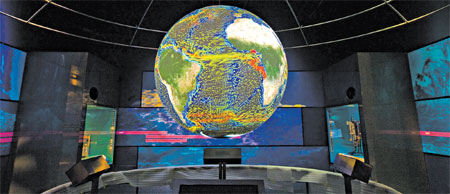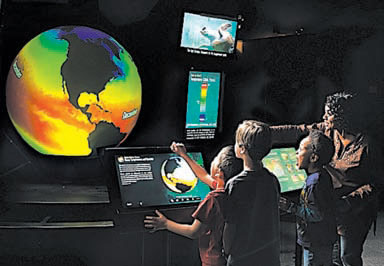Digital globes for earth study
Updated: 2013-01-27 08:25
By Mark Vanhoenacker(The New York Times)
|
|||||||
|
Science on a Sphere is a room-size globe developed by the National Oceanic and Atmospheric Association as a teaching tool. Animated images explain many of the complex aspects of oceans. Chip Clark / Smithsonian Institution |
|
Digital globes can display static images like topography and animate complex phenomena like weather systems. Children interact with a globe. Global Imagination |
In the main hall of the hands-on science exhibits at the Cape Town Science Center in South Africa, a lifeless, tattered globe stands under naked fluorescent bulbs, all but ignored by children passing through on school tours.
Across a sun-blasted courtyard and up a dingy staircase, another globe - a digital globe - stands in a darkened room. This globe is a shining sphere of light. Children stand awe-struck; adults of a certain age may be reminded of images like Apollo 8's Earthrise photograph.
Cost and technical limitations have largely confined these modern spheres to institutional settings like science centers. But as technology improves and prices fall, it's growing more likely that a digital orb will someday arrive in a classroom - or even a living room - near you.
Digital globes vary in size, but a typical model is 61 centimeters across. The image on a digital globe can be changed with the touch of a button. Controlled by a keyboard or tablet computer, a digital globe can toggle between familiar, static images, like the world's political boundaries, topography or vegetation. It can animate complex phenomena, like the formation of weather systems, the effect of global warming on wolverine habitats or the annual pulse of sea ice. It can display the surface of the moon, the churning azure cloudscapes of Neptune or the celestial globe - the night sky.
A digital globe can illuminate the human planet: wars, colonization, the formation of diaspora, modern trade flows or air traffic. It can also help teach math, play games, show movies or serve as a blank canvas for artists.
Michael Starobin, 44, a multimedia professional and the producer of seven spherical films, says this new world is limited by only one rule: "Respect the roundness."
For centuries mapmakers have tried to smooth a round planet onto flat maps with as little distortion as possible. Makers of globes confronted an opposite
problem: how to efficiently place or print information onto a spherical surface.
For digital globe engineers, the elusive goal remains a spherical computer screen. Edward R. Tufte, the author of "The Visual Display of Quantitative Information," is enthusiastic about the potential of digital globes to remind us of earth's offline realities - "by forgetting about the 3D whole Earth, flatland economic optimizing leads to global pessimizing" - as well as the possibility that a company like Apple will roll out a Retina-caliber spherical display. Until that happens, digital globes will rely on optical projectors. But how do you project an image so that it lands equally bright, focused and undistorted on the surface of a sphere?
There are various optical solutions. But the broadest distinction is whether the image is externally or internally projected. The market for externally projected globes - like Science on a Sphere, the popular devices installed at around 85 institutional locations - is limited by cost, the fixed nature of the installation and the fact that a viewer who gets too close may find herself contemplating one of the memorable descriptions of the Ottoman ruler Suleiman the Magnificent, "the shadow of God on Earth."
The digital globes that may soon break out of the museum use internal projectors. A small portion of the extreme Southern Hemisphere is blocked by their projector and base. Brightness, while vastly improved, also remains an issue.
But the biggest obstacle is cost: around $43,000 for a 61-centimeter diameter HyperGlobe from iGlobe of Franklin, New Hampshire; $40,000 for an 81-centimeter OmniGlobe from ARC Science of Loveland, Colorado; or $21,000 for a 61-centimeter Magic Planet from the market leader, Global Imagination of Santa Clara, California.
These prices, though, are falling. Mike Foody, the C.E.O. of Global Imagination, says that he hopes to have education-discounted prices down to $2,500 within a year or two.
In China, schools use them mostly to teach social sciences, like the geography of religion and language, and history.
If prices bring them into the realm of home use, think of music visualizations, digital aquariums, geotagged vacation photos and real-time flight tracking of your spouse's trip.
In the meantime, the Mayo High School in Rochester, Minnesota, has used a digital globe in earth science lessons since 2007. Lawrence Mascotti, director of the school's planetarium, said he finds the sphere a "more democratic" educational tool than textbooks or computer screens. While some children have difficulty with language-based concepts and mental manipulation, the digital globe works for nearly everyone, Mr. Mascotti says.
"It's simple," he said. "The mind follows the eye."
The New York Times
(China Daily 01/27/2013 page9)

